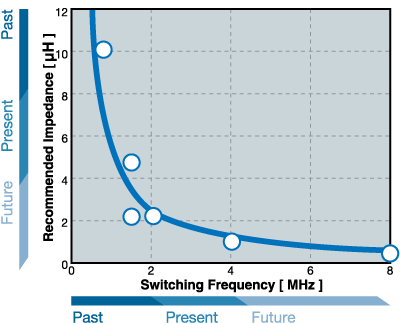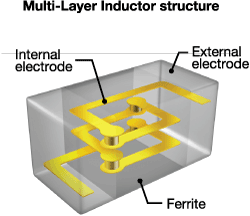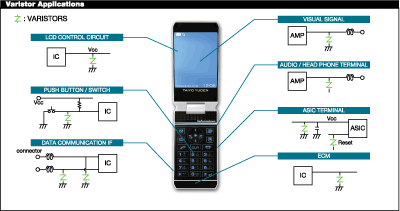Miniature component trends in handheld devices
Designers must continually pay attention to the growing need for smaller, more powerful components in mobile phones and other handheld devices
BY TAIYO YUDEN, U.S.A.
Schaumburg, IL
http://www.t-yuden.com
These days, having a mobile phone is a necessity of daily life. The global market for mobile phones has become polarized between the sleek high-end multifunction handsets and those on the lower end. In the European and U.S. markets, consumers have come to expect feature rich handsets and services such as e-mail, cameras, TV, Internet browsing, games, music and video downloads services, GPS, and electronic payment.
Meanwhile, global markets such as Southeast Asia, India, and Brazil are fueling the demand for less-expensive standard-feature handsets. Recognizing all needs of both ends of these vital markets, there are capacitors, inductors, and module cellular solutions.
Demands of RF circuits
In mobile phones, the core communication function is controlled by the radio frequency (RF) block. As mobile phone functions have multiplied, the RF block has been steadily constricted into a smaller space, making room for components such as the baseband circuit needed for the power supply.
As a result, RF circuits need smaller parts, the development of modules for its circuits, and miniaturization of the modules themselves, to trim the space requirements as much as possible. Therefore, the components in RF circuits must also be more compact while maintaining their high-frequency capabilities.
High-end mobile phones, besides using conventional high-frequency circuit blocks, are now regularly equipped with Bluetooth, GPS, and TV tuners, among other features. This adds to the demand for inductors with a higher Q value, along with an increased use of antennas and their matching applications.
Designers use high-frequency multilayer chip inductors designed with a higher Q value for high-frequency parts of matching networks and other systems. These multilayer chip inductors are a critical part of designing the RF block and will enable further functional upgrades and compact sizing of cell phones.
Smaller power inductors
Small power inductors are readily found in an assortment of popular consumer electronics, including mobile phones, HDDs, DSCs, DVCs, portable audio players, and ODDs for notebook PCs. In these size-conscious devices, weight and duration of operation are important considerations.
Each successive generation of devices includes more and more functions, which increases the number of circuit blocks, dc/dc converters and high performance inductors that are used. As devices become smaller and sleeker, smaller components are a necessity. In mobile phones, converters with four or five channels require either wire-wound or multilayer inductors, which are compact and highly efficient.
Mini power inductors
Like mobile phones, the ongoing trend of power supply applications in handheld devices is to achieve higher efficiency in a smaller size. To accomplish this, it is necessary to reduce the inductor size, number of components, or both. One solution is to increase the switching frequency of switching-type dc/dc converters. This decreases the inductance value, reduces the size of the inductors, does not require large capacitance and increases the transient response by the load fluctuation.
In the past, a 500-kHz switching frequency was used and the inductance ranged between 4.7 and 10 µH. But recently, the switching frequency has risen from 1 to 6 MHz, while the inductance value has actually dropped to 1 µH.
While increasing the switching frequency has its advantages, there are also disadvantages. As the switching frequency is increased, the switching element loss is also increased, lowering its efficiency. Therefore, the switching frequency cannot be increased without taking into consideration the development of devices and circuits.

Fig. 1. Inductance value in accordance with the switching frequency of stepdown dc/dc converters under certain conditions.
Figure 1 maps inductors with a rated current of 1 A. The vertical-axis is the inductor thickness. The lower hem of the horizontal axis indicates the switching frequency of the stepdown dc/dc converters, with the upper hem showing the inductance value. This represents the inductance value in accordance with the switching frequency of the stepdown dc/dcconverters under certain conditions. When using a switching frequency of 300 kHz, an inductor size of 4.0 x 4.0 x 1.8 mm is required.
As the switching frequency increases to 1.5 MHz, a smaller 3.0 x 3.0 x 1.0-mm inductor may be used which allows for lower-profile designs. As the switching frequency increases ever further, the inductance value will likewise be decreased, enabling use of even smaller inductors.
Inductor thickness has also continued to shrink. Just a few years ago most mobile phone inductors were 2.0 mm thick, while recent designs have slimmed down to 1.0 mm. Still, even thinner and more efficient inductors are in demand due to current size, design, and performance considerations.
Size-optimized inductors
The key to the space-saving design of wire-wound inductors is its sleeveless and coreless structure, which is formed with only a drum core by using a specialized ferrite powder resin coating technology.

Since this method leaves no air gap between the drum core and the sleeve core, the inductor resists eddy currents to lower the resistance of alternating current. The structure is strong, due to its resin coating, and also enables greater power supply efficiency, which are critical for small devices. Another size-optimized wire-wound inductor design solution is to eliminate all structurally wasted space. The result is a 50% reduction in surface area and a huge reduction in direct current resistances, when compared to conventional inductors, while still retaining high-rated current and low Rdc.
Mobile phones, digital still cameras, portable music players, and other mobile equipment need to be compact and thin, but they also require compact, low-profile yet high-efficiency dc/dc converters to ensure maximum use of limited battery power. Shrinking the size and height of the dc/dc converter requires reduction of the size and height of its main component, the choke coil, which occupies the largest volume inside the dc/dc converter. As a result, multilayer inductors have become the usual choice when a a low profile of 1.0 mm or less is required. However, Rdc tends to rise when multilayer inductors are made smaller and lower profile, adversely affecting the efficiency of dc/dc converters. It has been generally assumed that performance levels cannot be maintained when reducing dc/dc converter size and height.
Multilayer inductors are structured by printing the external electrodes on a sheet that connects the layers with a through-hole, and forming the external spiral electrodes.

The new design of multilayer power inductors also features reduced Rdc by up to 35%, allowing the inductors to achieve improved basic performance as well as multilayer structure.
Challenges in system design
Receiver desense is one particular type of electromagnetic noise problem that has cropped up within the mobile phone circuit system over the years. A unique problem, receiver desense occurs when the circuit block is located adjacent to the RF block, causing deteriorating receiver sensitivity due to electromagnetic noise from the circuit block. This may interfere with hearing voices clearly when electromagnetic noise from a camera transfer signal interrupts the receiver sensitivity of the RF circuit.
The solution to this problem is to insert EMC components in the bus line. Common mode chokes can be used for high-speed differential data lines such as USB, MDDI, and MIPI applications.
Static electrical charges are another common problem in mobile phone design. Special terminals are needed as a countermeasure against static electric charges, especially around the keypad and headphones.

Previously, designers secured the pathway from the capacitors to the package by using zener diodes, but now the chip varistor has changed everything. Ultrasmall chip varistors, which use advanced ceramic material technologies, are the latest solutions for combating static electric charges.
Future trends
Looking ahead, the overall demand for mobile phones, including smart phones, will continue to grow. Low-end mobile phones designed for developing countries such as India and Brazil will become an increasingly larger market.
Recent developments in smart phone technology suggest that the concept of a mobile phone only used to place calls is a thing of the past. Mobile phones will continue to be multifunctional, handheld terminals for a multitude of applications. ■
Advertisement
Learn more about Taiyo Yuden





